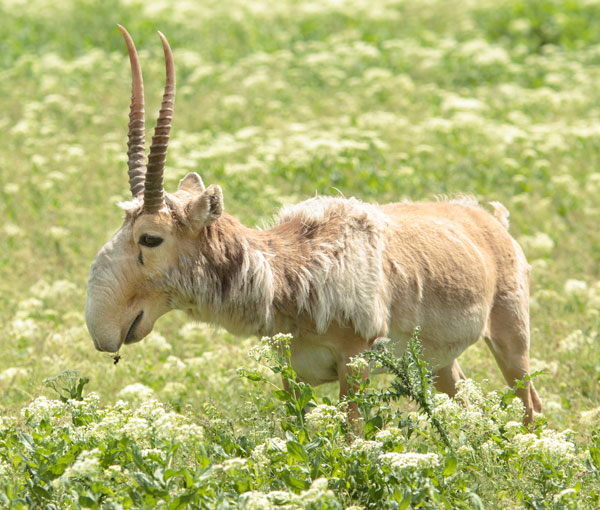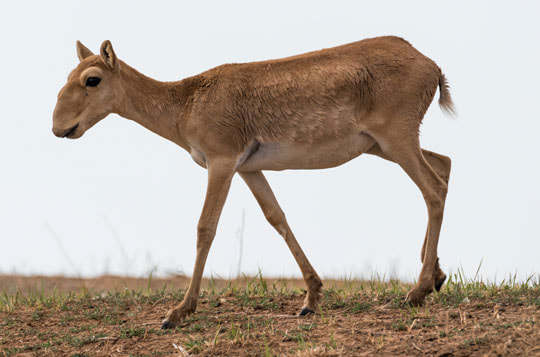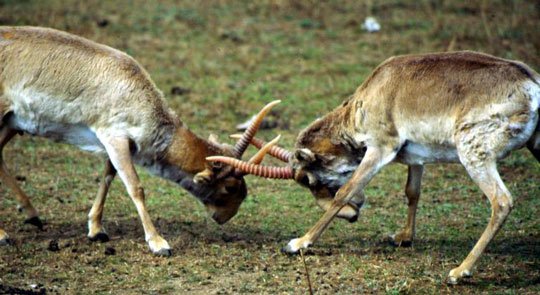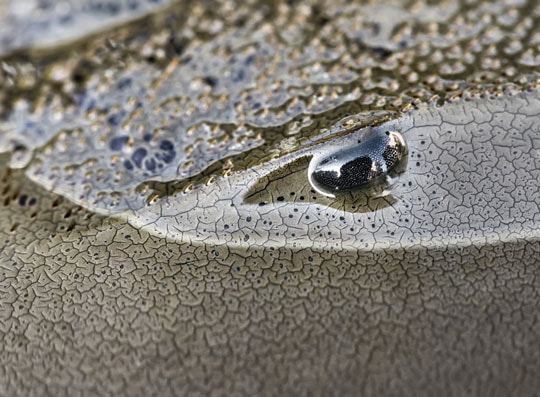|
The first time I saw a photo of a saiga antelope, I thought it must be a creature from one of the Star Wars movies, with its huge eyes and its strange snout. Nope, it's real. Let's figure out what this crazy creature really is, shall we? What the heck is a Saiga Antelope? The saiga antelope is an endangered species that lives only in Russia, Kazakhstan, and Mongolia, although it used to have a much wider range. This antelope lives in harsh, semi-arid grasslands, and it migrates hundreds of miles each year between summer and winter. The saiga is relatively small for an antelope, usually only 24 to 32 inches (61-81 cm) high at the shoulders, and weighing between 60 and 150 pounds (26 to 69 kg). In other words, about the size of a German Shepard. The most striking feature of the saiga antelope is its strange, bulbous nose. Amazing Facts about the Saiga Antelope First we need to discuss the saiga's strange nose. What's up with that schnoz? The nose has two enormous, proboscis-like nostrils that drape over the mouth and point straight down toward the ground. Why? No one knows for sure, but we have some ideas. In order to figure out the purpose of this extraordinary snout, scientists in 2004 dissected and examined several. They found numerous large chambers within the nostrils. As the animal breathes in, the dust is filtered out by these chambers before the air reaches the lungs. This makes sense because saigas migrate in large herds, and much dust would be kicked up by all those hooves. Another obvious benefit of these chambered nostrils is that they would warm the cold air in the winter and cool the hot air in the summer. And finally, perhaps the main function of these cavernous sniffers is that they help the male saigas attract mates. The males emit a loud nasal roar to impress the females. The bigger the male's body size, the bigger its nose and the louder its nasal roar, allowing females to choose the healthiest mates. This doesn't work for me... when I blow my nose, Trish isn't the least bit impressed. This mate selection hypothesis is supported by the fact that female saigas have much smaller noses than male saigas. Here is a female: Saigas graze in herds, usually in fairly flat, dry grasslands, semi-deserts, and steppes (a steppe is a type of grassland where there are no trees other than near streams and lakes). They prefer open areas where they can see predators approaching from a long distance. This is not surprising considering saigas are often hunted by wolves, and young saigas are often taken by foxes and eagles. During the annual migrations, saigas group together into large herds of thousands of animals. When the migration is over, they form smaller herds of only 30 to 40 animals. In the rutting season, males start to get pretty serious about things. Not only do they use their snouts to impress females, they must first take possession of a harem of up to 40 females. This is no easy task, and the males sometimes fight to the death in the process. Take a look at those horns on the males. No wonder these fights can be dangerous! After winning a harem, the males must continue to fight off new challengers, and then there is the tedious business of mating with all those females. After this is all said and done, the males are so weak that many of them die off. After a gestation period of about 145 days, the females give birth, usually to twins. Only about a third of births are individual babies. Because of the risk of predators, young saigas are up and on their feet within a few days, and they are weaned within four months. It's difficult to talk about the saiga antelope without discussing this creature's unfortunate decline in recent years. For at least as far back in time as the last ice age, which ended about 10,000 years ago, saigas grazed over vast areas of Asia and Europe. They were probably a favorite prey animal for saber-tooth tigers and cave lions. The populations were still immense through the 19th century and into the 20th century. Well, you can probably guess at least part of what happened then, right? In the first half of the 20th century, saigas were widely hunted by humans, but this hunting was well managed and had little impact on the populations. However, the fall of the Soviet Union in the early 1990s changed everything for the saiga. The hunting regulations disappeared. Rural economies of the countries where the saiga lived were devastated, resulting in poverty and unemployment, which resulted in greatly increased hunting for saigas, for their meat and for their horns, which could be sold to China, where they are used in traditional medicines. Even today, China purchases huge numbers of saiga horns. Amazingly, in just the last 15 years, saiga populations have decreased by 95%. The good news? Numerous zoos and other organizations are working with experts from Russia, Kazakstan, Uzbekistan, China, and Mongolia to develop international strategies to save the saiga antelope from extinction Check out this video about the saiga antelope. So, the Saiga Antelope deserves a place in the C.A.H.O.F. (Cracking Animal Hall of Fame). FUN FACT: The adjective cracking (at least in the way it's used here) originated in about 1830. With this usage, the word means "very impressive or effective," and is often used to describe literature, such as "Stan tells cracking tales of adventure." The word can also be used as an adverb meaning "very or extremely," such as "a cracking good novel." Wait, there's more! The word can also mean "to start doing something quickly," as in "Let's get cracking." And... the word can mean "precise or smart," such as "The guard gave a cracking salute." Anyway, I like the first definition given above, in which cracking is another way to say awesome! Photo Credits:
Male saiga on green field - DeopositPhotos Male saiga head and snout - Andrey Giljov, Wikimedia Commons Female saiga antelop - DepositPhotos Male saigas fighting - U.S. Fish and Wildlife Service Headquarters, Public domain, via Wikimedia Commons Young saiga - DepositPhotos Saiga herd - DepositPhotos
0 Comments
Perhaps recently you have read news articles about the importance of horseshoe crabs in the development of the COVID-19 vaccines. That's pretty interesting, but the horseshoe crab was an awesome animal way before its blood was used in medical research. In fact, these creatures have been awesome animals for nearly 450 million years! What the heck is a Horseshoe Crab? Well, first, they aren't crabs at all (and obviously they aren't horseshoes). In fact, they aren't even crustaceans. Instead, they are related to spiders. Recent studies have placed them into the class Arachnida. Horseshoe crabs get their name from their horseshoe-shaped carapace (the largest part of their exoskeleton). They grow to about two feet long (61 cm), weigh up to ten pounds (4.5 kg), and live up to 40 years. There are four living species of horseshoe crabs, and they live in shallow coastal waters through much of Asia and the Pacific and on the Atlantic coast of North America and the Gulf of Mexico. Amazing Facts about the Horseshoe Crab Okay, I know you want to ask, why isn't the horseshoe crab a crab? It kind of looks like a crab. It lives in oceans. It has an exoskeleton and crawls around in the water on jointed legs. Therefore it seems very crabby. Still, not a crab. Crabs, along with lobsters, crayfish, and others, are in the class Crustacea. Crustaceans are in the huge phylum Arthropoda. Horseshoe crabs are arthropods, but they are not crustaceans. They are in their own class of arthropods called Merostomata (which means "legs attached to the mouth"). Enough with the fancy names already—why aren't these things considered crabs? Structurally, they are quite different from crabs. For example, horseshoe crabs do not have antennae. Also, they do not have mandibles (mouth parts for chewing food). Instead, they have a pair of small appendages called chelicerae, which help them shove food into their mouths. You know what other animals have chelicerae? Spiders. Here's what the underside of a horseshoe crab looks like. Can you spot the two chelicerae in front of the five pairs of legs? By the way, it's not a good idea to hold a live horseshoe crab by the tale like that, as this can harm the animal. Horseshoe crabs are often called "living fossils." This is because they have existed for a really long time without changing much at all. The've been around, basically in the same form, since long before dinosaurs existed. The oldest fossils of horseshoe crabs are from a species that lived about 450 million years ago, and those looked very much like the horseshoe crabs living today. Scientists believe the closest relatives of horseshoe crabs are the sea scorpions, which originated about 467 million years ago. Sea scorpions are extinct now, but they were impressive creatures. Some were among the largest arthropods that have ever lived. See the size comparison diagram below, showing six of the largest known species of sea scorpions. Interesting thought: Why do some types of creatures exist for hundreds of millions of years without many changes to their basic form? There can be several reasons for this, but perhaps the easiest to explain is that some creatures have a body form that is already perfectly suited to the creature's niche (its specific environment, food source, etc.). Sharks are an example. And, of course, horseshoe crabs. Basically... if it ain't broken, don't fix it. A horseshoe crab is basically an armored tank. Its entire body is covered by a protective shell. It walks around on the subsurface sand or mud on its five pairs of walking legs, and it preys on numerous types of sea worms, crustaceans, and clams. A horseshoe crab gets its oxygen from the water using a series of book gills between the legs and the tail (see the book gills in the red outline below). These book gills get their name from the book-like arrangement of gills. Each one of the ten gills contains hundreds of layered folds called lamellae. So, it's kind of like ten books, and each book has hundreds of pages. This increases the surface area for absorbing oxygen. Horseshoe crabs have amazing eyes. They have two prominent compound eyes on top of their shell. Compound eyes are made up of numerous smaller eyes, called ommatidia. Most arthropods have these (think of a fly's eye). Each of the horseshoe crab's compound eyes have about 1,000 of these ommatidia. But wait, there's more! In addition to the two compound eyes, these creatures have a pair of median eyes, a pair of lateral eyes, a pair of ventral eyes near the mouth (which is between the five pairs of legs), and they also have a group of specialized photoreceptor eyes on the tail. They have a plethora of eyes! Although they cannot see fine details all that well, horseshoe crabs are amazing at seeing color and light levels. In fact, their cones and rods are the largest of any animal—100 times larger than those in humans. Amazingly, during the night their eyes are a million times more sensitive to light than during the day! Below you can see one of the compound eyes. Check out this video about horseshoe crabs. Horseshoe crabs have been used in medical research for decades, particularly their blue blood. In fact, every pharmaceutical company in the world relies on horseshoe crabs. Why? Because their blood contains a substance with the tongue-twister name limulus amebocyte lysate. This substance is important because it detects endotoxin. What is endotoxin? It's a contaminant that can can kill you if it happens to get into vaccines, or any injectable drug. It's impossible to understate the importance of this substance. A gallon of the stuff is worth $60,000. Here's the bad news. Pharmaceutical companies catch half a million horseshoe crabs each year (the harvesting is regulated). They remove a portion of each crab's blood, then they release the crab. However, many of the released crabs are weakened, and they die. This practice, along with fishermen overharvesting horseshoe crabs to use as bait, is resulting in the crab's decline. As you can imagine, the intense efforts to develop COVID-19 vaccines has resulted in more crab blood needed. Here's the good news. A synthetic alternative to this substance has been developed. It has been approved for use in Europe, and some US companies have also started using it. The synthetic alternative is slowly catching on, so maybe eventually we will no longer need to harvest horseshoe crabs for this purpose. So, the Horseshoe Crab deserves a place in the S.A.H.O.F. (Splendid Animal Hall of Fame). FUN FACT: The adjective splendid originated in the 1620s. It probably came from the Latin word splendidus, which means "bright, shining, glittering." Today, splendid is used to describe just about anything good, and it has a broad range of meanings, including gorgeous; magnificent; sumptuous; grand; superb; distinguished or glorious in name, reputation, or victory; strikingly admirable; possessing great talents; excellent; fine; very good; and brilliant in appearance. I guess it's an all-around useful word for praising things. So, splendid is another way to say awesome! Photo Credits:
Horseshoe crab #1 - Pos, Robert, USFWS, via PIXNIO Holding a horseshoe crab - DepositPhotos Underneath side of horseshoe crab - DepositPhotos Sea scorpion size diagram - Wikimedia Commons Horseshoe crab compound eye - DepositPhotos |
Stan's Cogitations
Everyone needs a creative outlet. That's why I write. Archives
July 2024
|












 RSS Feed
RSS Feed